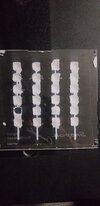this is a touch pad from an early 90s snap on automotive scope. the problem is button #8 doesnt work. the connector to the board is 13 pin. looking at the pic, the second from the left is ground. the next 8 dark green lines are buttons 1-8. all the green lines are high ( 5V) and each goes low when you press the switch for the line. they dont go completely low, they drop to around 1.5V. the white lines are low, and go high when you press the non numeral buttons. the 1-8 numerals correspond to numbering the cylinders of a car. if it asks how many cylinders, buttons 1-7 will each show on the screen. 8 does nothing. when i press 8 , the line for 8 stays high. bad button? not sure. if i ground the line for 8 and pull the line low, i dont get an 8, i get a reset, but like i said, working buttons drop to 1.5v . maybe i need something in line to prevent the line for 8 to drop to zero when i manually ground it? somehow keep it at 1.5v when pulled low? i dont really know how the pad works. i will never get a schematic for this, snap on keeps everything under wraps. 24 buttons, with 13 pins on the connector. i guess some kind of matrix, but im familiar with strobes on one side, and returns high. 4 strobes, 4 returns 16 possible switches. not sure how they get 24 out of 13 pins. i lifted the membrane on a good switch, and touching it with a small brass conductive bristle brush makes the switch work, as does pressing the membrane. i removed button 8 membrane, and the bristle brush doesnt pull the line low. again, touching that line for button 8 to ground, pulling it low, doesnt register an 8, it registers a reset. if i knew how it worked, i could possibly put in a momentary switch to use as button 8. ps- the button 8 was probably used more than the others, a lot of 8 cylinder cars back then. other than the first green line( pin 2 ) going to ground, all the other pins go through a pull up resistor to a 74ls245n . i tried a different 74ls245n, no joy. hope this makes sense, ive hit a wall. i am in no way an electrical engineer or wiz, im more like a very good plumber for electrons. anyway, thanks to all










